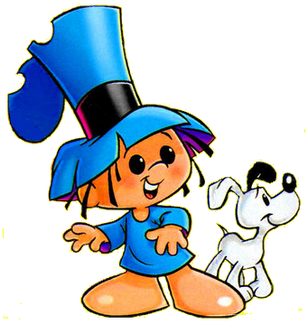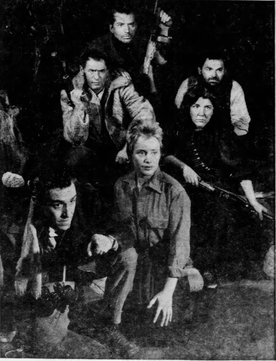
Edmund Pevensie is a fictional character in C. S. Lewis's The Chronicles of Narnia series. He is a principal character in three of the seven books, and a lesser character in two others.
The Lord of Lorn and the False Steward or The Lord of Lorn and the Flas Steward or The Lord of Lorn is Child ballad number 271.

The Adventures of Quentin Durward, known also as Quentin Durward, is a 1955 British historical film released by MGM. It was directed by Richard Thorpe and produced by Pandro S. Berman. The screenplay was by Robert Ardrey, adapted by George Froeschel from the 1823 novel Quentin Durward by Sir Walter Scott.

Hijitus is an Argentine comic superhero created by Manuel García Ferré. He made his debut in September 1955 in the comic strip The Adventures of Pi-Pío, published in Billiken magazine. In his debut he wear a bowler hat, but when it was republished in the Anteojito magazine, it appeared with a top hat, he was only a side character then, but after having some modifications became the protagonist of his own action comedy animated series The Adventures of Hijitus which was broadcast in Argentina between 1967 and 1974. Later it in the 1990s and in 2010-2012 was broadcast again through El Trece channel with a high audience rate. He is one of the best-known Argentine comic characters, along with Patoruzú, Mafalda, Clemente and Juan Salvo "Eternauta". The TV series is frequently re-transmitted on Argentinian television as many Argentinians perceive it as nostalgic.

El Libro de piedra is a 1969 Mexican supernatural horror film, written and directed by Carlos Enrique Taboada. This film was remade in 2009.

Fantaghirò is a 1999 Spanish-Italian fantasy animated television series loosely based on the Italian live-action film series Fantaghirò. It was created by BRB Internacional with animation by Colorland Animation Production, written by Francesca Melandri, Giovanni Romoli and Lamberto Bava, produced by Mediaset, Telecinco and Grupo Planeta, with music by Mark Bradley and Terry Wilson. A 75-minute animated film Fantaghirò: Quest for the Kuorum edited together using footage from the series was released in 2000.
Trapito is a 1975 Argentine comedy-drama adventure animated film directed by Manuel García Ferré.

Manuel García Ferré was a Spanish Argentine animation director and cartoonist.
"The Lochmaben Harper" or "The Blind Harper" is a traditional British Folk ballad and is one of the ballads collected by Francis Child in The English and Scottish Popular Ballads (1882–1898).

Hellboy: Wake the Devil is a five-issue comic book mini-series in the Hellboy franchise, conceived and illustrated by Mike Mignola and published by Dark Horse Comics. Various elements and sections of plot were later used in the animated film Hellboy: Blood and Iron.

Hellboy: The Wild Hunt is the ninth collected edition in Mike Mignola's Hellboy comic book series, the second of three connected story arcs written by Mignola and illustrated by Duncan Fegredo. Its eight chapters, collected in March 2010, were originally released from December 2008 through November 2009 as issues 1-8 of the Hellboy: The Wild Hunt limited series, also numbered as issues 37 through 44 of the continuing Hellboy series. The storyline delves into Irish and Arthurian legend, reprising several characters first introduced in Hellboy short story "The Corpse". As with Hellboy stories generally, it was published by Dark Horse Comics.

The Three Musketeers is a 1953 French-Italian historical adventure film based on the 1844 French The Three Musketeers. This adaptation is one of five films director André Hunebelle and screen writer Michel Audiard achieved together. Georges Marchal portrayed d'Artagnan.

The Humpbacked Horse is a 1941 Soviet fantasy film directed by Alexander Rou and produced at Soyuzdetfilm studios. It is based on a fairy tale by Pyotr Pavlovich Yershov. Like most of Rou's earlier movies, it was in black and white
Kids of the Round Table is a 1995 Canadian/American fantasy film written and directed by Robert Tinnell. Malcolm McDowell, Michael Ironside and newcomer Johnny Morina star in a modern-day adventure filled with medieval magic.

"For Whom the Bell Tolls" was an American television play broadcast in two parts on March 12 and March 19, 1959, as part of the CBS television series, Playhouse 90. It is a television adaptation of the 1940 novel by Ernest Hemingway. John Frankenheimer was the director. The cast included Jason Robards, Maria Schell, and Maureen Stapleton.
The Tale of the Woodcutter and his Daughters is an Egyptian folktale related to the international cycle of the Animal as Bridegroom. It mostly follows subtype ATU 425D, "The Vanished Husband", which segues into tale type ATU 425B, "The Son of the Witch", with the heroine's tasks for the supernatural husband's mother - subtypes of the more general type ATU 425, "The Search for the Lost Husband".
The Horse Lurja is a Georgian folktale about the friendship between a princess and a magic horse, which sacrifices itself for her after it rescues her from great peril. Although the tale appears in Georgia, some scholars recognize similar narratives in Central Asia and across Europe.
Donotknow is a Russian fairy tale (skazka) collected by folklorist Alexandr Afanasyev in his three-volume compilation Russian Fairy Tales. The tale was also translated as "Know Not" by Jack V. Haney.










